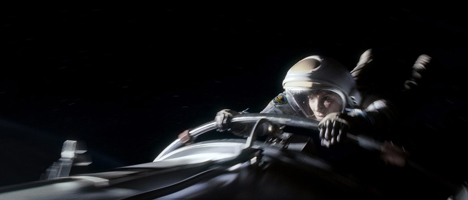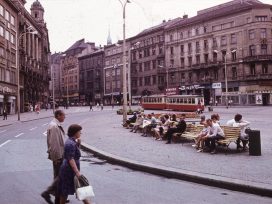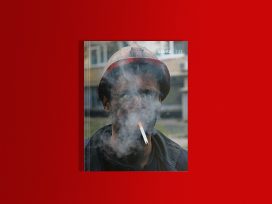The existence of a public realm depends entirely on permanence. If the world is to contain a public space, it cannot be erected for one generation and planned for the living only; it must transcend the life-span of mortal men. Without this transcendence into a potential earthly immortality, no politics, strictly speaking, no common world and no public realm, is possible. The common world is what we have in common not only with those who live with us, but also with those who were here before and with those who will come after us. But such a common world can survive the coming and going of the generations only to the extent that it appears in public.
Hannah Arendt, The Human Condition
1. We all know the dream. In a very generic vision of freedom, you’re out running. When you jump over a fence or some other obstacle, instead of landing you suddenly keep levitating, up, up and away, until you find yourself freely floating in the air. The first sensation can be a sensation similar to fear, a sudden and tingling panic of a loss of control, which slowly gives way to a triumphant feeling of sovereignty and invincibility. I don’t have this dream very often anymore.

Still of Sandra Bullock in Gravity (2013). Photo: © Warner Bros. Entertainment Inc. Source: IMDb
2. This text has been written from various positions of doubt, or maybe rather a number of constructive dilemmas.
3. Contemporary economy is ideologically colour-blind; it is simply totally indifferent to resistance. Its main propellant is difference. The difference between the yellow Nike of the last month and the blue Asics of the next week; the tiny glitches separating one category of identity from the other. Because in the logic of contemporary economics, every new category of identity means a new target group. Capitalism doesn’t care one bit about the objective or the ideological agenda behind my projects; as long as they produce difference, they fulfil their task as the fuel making the wheels turn faster.
4. When writing applications for art grants in Sweden, you are asked to define in what way your work – “the project” – is developing/enabling new artistic forms. Yes, of course. But what do we do with all the old, already existing art? And when working with projects aiming at the production of new knowledge, how do we relate to the knowledge from last years’ workshops and platforms? It is a machine for the continuous production of discursive and aesthetic redundancy, like gadgets and clothing; following the logic of novelty/fashion, where the task of the new product/knowledge is to outdate the previous.
Yesterday’s knowledge, strategy, concept, or notion has to be outdated; not because it has actually stopped being useful or interesting, it has just become a bit old. It’s an obstacle, it stands in our way. In the accelerated logic – where we stay afloat as long as we keep moving, where speed and flexibility is the recipe for our super-powers – neither knowledge nor discourse has the objective of actually interacting with society or its institutions. It has become a field of its own, separated from the political reality. The real task of the new concept is to keep its predecessor out of reach.
5. SANDRA BULLOCK I:
At 600 km above planet Earth, the temperature fluctuates between +258 and -148 degrees Fahrenheit. There is nothing to carry sound. No air pressure. No oxygen. Life in space is impossible.
Thus starts the film Gravity from 2013. I find the kind of unexpected success of the film interesting. How could it be that a movie with only two characters and a story that could be told in half a sentence had such a big impact? Of course, the camera work and the special effects were both spectacular and subtle, George Clooney’s smile as captivating as ever, and nobody beats Sandra Bullock when it comes to combining larger-than-life beauty with the qualities of average next-door everydayness. But there must be some other explanation to why the movie was so mesmerizing.
My first thought was that it was the first movie that made me feel like it actually was conceived in a 3D logic – the priority of space before the story making it a moving sculpture rather than a moving image. Then I for completely other reasons spent some time reading Hannah Arendt’s The Human Condition, which opened up a different perspective and potential for the film’s narrative. There is an interesting parable between existence in space – the ultimate version of our wish to escape the human condition as “mere earth-bound creatures” – and the contemporary economy, capitalizing the virtual values of mental processes rather than the material products.
Life in space is impossible. But it’s neither the extreme temperatures nor the lack of oxygen that make existence in space impossible. Rather, as the title suggests, all threats appear as a result of the lack of gravity. Hit by debris from another high-tech communication centre, Sandra Bullock is thrown out spinning into the black void.
– Give me your position!
– I don’t know, I don’t know! I… I am spinning! I can’t… I can’t …
– Report your position!
– GPS is down, I can’t, it’s down… I can’t
– Give me a visual!
– I see nothing!
– You need to focus! Anything!
There is no up and no down: once you are set in motion, the accelerated movement continues eternally, and just the idea of getting an overview of even your most immediate territory is ridiculous. Without a force that pulls bodies down to some foundation or point zero, the possible consequences of even the smallest event – dropping a bolt, or the minimal thrust that sends you moving into infinity – is beyond comprehension. Not because of the force of the act itself, but because there is no counter-force. Totally liberated from any form of inertia or the fixating energy of a common centre, any move might send me tumbling away in the isolation of sovereign solitude.
The longing to escape being bound to earth becomes, when fully realized, an existence of infinite terror. In a world defined by its lack of contra-powers, every initiative can evolve into a potentially devastating threat to your very existence.
6. Yesterday I did not participate in the counter-demonstration against a manifestation by The Party of the Swedes, a neo-fascist party touring the Swedish cities trying to gain ground in the upcoming elections. Last Sunday I did participate in the same event in Gothenburg, where I am currently working, but yesterday in Stockholm I did not. It wasn’t really an active choice, it just happened that way. It feels wrong that I did not participate.
When the neo-fascists visited Malmö a couple of days earlier, it came to violent clashes when the police protecting the fascist manifestation provoked the leftist activists in a series of confrontations leading to a completely uncalled-for level of violence. Participating at the event in Stockholm would have doubtlessly been the right thing to do.
And yet, in Gothenburg we were 2500 demonstrating against maybe 10 to 15 fascists, drowning the voice of their leader in whistles, choirs, and rattling keys. In Stockholm, the news reported that 14,000 people gathered to protest against 100 fascists; again shouting, whistling, and chanting, expressing resistance to the growing wave of racism and fascism. More than one week of medialized momentum, a fortnight before the elections on 14 September 2014; the images and sound of politics, confrontation, and conflicts at an event initiated by a fascist party. The resistance they met was their manifestation.
7. Over the last decade, I must have used the term “difference” in hundreds of applications, project descriptions, and essays. An endless row of platforms and projects aiming at the “multitudes” of identities/forms of expression/subjectivities/practices – the content has varied, but the objective has always been defined with this rather generic criteria of “difference”. Difference is good; no matter if I work with a theatre project or launch a pedagogic platform, my work is somehow always based on the objective of enabling as many different perspectives and subjectivities as possible to share a temporary time-space. This, I still think, is something positive.
8. In her essay “The institution of critique”, Hito Steyerl writes:
If in the first wave of institutional critique criticism produced integration into the institution, in the second one only integration into representation was achieved. But now in the third phase there seems to be only integration into precarity. […] Critical institutions are being dismantled by neo-liberal institutional criticism, this produces an ambivalent subject which develops multiple strategies for dealing with its dislocation. It is on the one side being adapted to the needs of ever more precarious living conditions. On the other, the need seems never to have been greater for institutions that could cater to the new needs and desires that this constituency will create.
Over the last half-century, the repeated waves of institutional critique have been the vitalizing engine of artistic development in the western hemisphere. Fields and individuals that have practiced a continuous reflection and expanded the thresholds, limitations and possibilities of their institutions – buildings, organizations and aesthetic tradition – have flourished, whereas those who have stayed passive in relation to the institutional function of normative authority and the gatekeeper have stagnated. This much we know.
The institutions of the twentieth century still carried the legacy of the nation-state, operating as an apparatus to define the narratives of coherent national identities. This task, most of us today would say, has become significantly outdated – but only on a superficial level. It’s of course difficult for any serious museum, theatre, or university to formally claim to represent the true Swedish/German/Croatian identity. But on the other hand, this primary, central objective hasn’t really been replaced by any other aim or task.
We are often using the metaphor of the dinosaurs for these big, clumsy, and old organizations – but what happens if we follow the line of comparison? Is a society without institutions still a society? How can we think institutional critique in the context of the institution as an endangered species? In our time – when a post-Fordist economy is transforming existing platforms into cultural shopping malls, where knowledge, aesthetics, and politics are produced and consumed in as generic forms as possible – is it possible to rethink and reclaim the institution as a necessary mediator between society and its citizens?
9. All the knowledge produced in all the platforms, residencies, temporary communities – where does it go? What happens to it? All the collaboratively produced toolboxes, all the texts written in all the collectively edited publications – where do they go? All the processes – aesthetic, political and pedagogic – with an explicit or implicit objective of addressing the ascendant neoliberal capitalism; where do they end up? Of course, most of us agree that there can’t be any rational causality between artistic work and the “real” world – as Ad Reinhardt once said: “Art is art and everything else is everything else”. But still?
10. In 1988, after the introduction of the Perestroika, but before the fall of the Soviet Union, the president of the United States of America, Ronald Reagan, gave a speech at the Moscow State University. One decade before the Internet became accessible to the average citizen, the former Hollywood Cowboy addressed the need of universally embracing what he called the “new economy”.
Standing here before a mural of the Soviet revolution, I want to talk about a very different revolution that is taking place right now, quietly sweeping the globe without bloodshed or conflict. Its effects are peaceful, but they will fundamentally alter our world. It’s been called the technological or information revolution, and as its emblem, one might take the tiny silicon chip. Information technology is transforming our lives. Microcomputers today aid the design of everything from houses to cars to space crafts; they even design better and faster computers.
We’re emerging from the economy of the Industrial Revolution – an economy confined to and limited by the Earth’s physical resources – into “the economy in mind”, in which there are no bounds on human imagination and the freedom to create is the most precious natural resource. In the new economy, human invention increasingly makes physical resources obsolete. We’re breaking through the material conditions of existence to a world where man creates his own destiny.
Today the world looks expectantly to signs of change. There are some, I know, who fear that change will bring only disruption and discontinuity, who fear to embrace the hope of the future – sometimes it takes faith. It’s like that scene in the cowboy movie Butch Cassidy and the Sundance Kid.
The posse is closing in on the two outlaws, Butch and Sundance. They find themselves trapped on the edge of a cliff, with a sheer drop of hundreds of feet to the raging rapids below. Butch turns to Sundance and says their only hope is to jump into the river below. But Sundance refuses. He says he’d rather fight it out with the posse, even though they’re hopelessly outnumbered. Butch says “That’s suicide” and urges him to jump. Sundance still refuses and finally admits “I can’t swim.” Butch breaks up laughing and says “You crazy fool, the fall will probably kill you.”
And by the way, both Butch and Sundance made it, in case you didn’t see the movie.
11. The institution is neither constituted by the people inhabiting it nor by the walls defining its physical limits, but rather by how the result of the total potential produced within its structure is implemented, translated, and communicated into the public sphere as collective property and experience.
12. The old trope of the avant-garde vs. the mainstream is no longer valid; nor is the dichotomy of the elite vs. the common man – in terms of aesthetics, this always was a pseudo-opposition anyway. Not even the idea of the autonomous artist vs. the institution makes sense anymore; these are all figures of fake dialectics. The important question is: where do they meet, what interface do they have to share?
13. In February 2014, Facebook announced that its users are no longer limited to choose between the two genders “female” and “male”. As of 13 February, the social network allows us to express our unique individuality through no less than 56 gender identities. This, of course, is a victory not only for everyone describing themselves as queer, LGBT, or transgender, but also for the rest of us who feel general resistance against being boxed in and inscribed into narrow social categories. But on the other hand, Facebook is a company making their profit mainly by providing targeted advertisement. And as of 13 February, Facebook can offer no less than 54 new target groups to their advertising customers.
14. SANDRA BULLOCK II:
– Why is all this happening? What did we do? Bomb the guy’s country or something?
– It’s just a guy who wants money.
– So, what’s this guy’s deal?
– A while back he held some people for ransom. It went sour and now he’s a little pissed at me.
– What does that have to do with us?
– Nothing. It’s a game. If he gets the money, he wins. If the bus blows up he wins.
– What if you win?
– Then tomorrow we play another one.
– But I’m not available to drive tomorrow. Busy.
In Speed (1994), Sandra Bullock is a random passenger who for random reasons finds herself behind the steering wheel of a public bus. She then spends the major part of the film’s 115 minutes driving the bus, a task with the sole objective of keeping up the speed. She has boarded the bus in Santa Monica, running with a coffee cup in hand, shouting to the bus driver – whom she knows by his first name: “Andy, wait!” – the usual morning routine. Now Andy is wounded, randomly shot by a random passenger, and Sandra Bullock is thrown head first into a situation of continuous urgency. The vehicle is moving along Highway 10, direction Downtown, with an attached bomb controlled by the speedometer, forcing her to keep the speed; should she let the meter drop below 50 mph, the bus full of passengers will immediately explode.
The bad guy is a former cop seeking both money and revenge. His only motive is anger and resentment for the lack of gratitude from a society he has served his entire life. The timer of the bomb is a cheap, fake gold watch the LAPD gave him on the day of his retirement. History is coming back, the consequence of past politics is taking its toll; the only way to avoid the inevitable moment where we have to settle accounts with our past is to accelerate, to keep speed, and the smallest loss of momentum means confrontation and a devastating conflict.
Sandra Bullock’s position is existence without any plans for the future; it is all about inventing new strategies for staying in course without dropping speed, one block and one minute at a time. Temporary solutions to a constant, endless series of temporary emergencies. The passengers’ temporary applauses for her temporary victories linger a couple of seconds; a brief moment of catching our breath before a new strategy to maintain speed has to be invented.
15. We are creating an infinitely increasing number of platforms to produce difference. Temporary residencies and workshops, platforms and autonomous art collectives, they all produce new and differentiated toolboxes and strategies, supporting differentiated subjectivities and agendas. This apparatus is the inevitable logic of our contemporary modes of production – festivals, projects, temporary collaborations – focusing on an accelerated production and expression of identity and subjectivity, rather than the implementation and negotiation of the produced notions and tools in the public sphere.
Where do these different identities meet to negotiate their differences? Where is the space where these new and differentiated subjectivities have to confront their different positions and agendas with each other? And where do we deal with the strategies, toolboxes, and agendas that we produced last week?
16. The institution is slow, it is everything but contemporary; it’s not flexible, it is by definition heavy to move and conservative in taste as well as modes of productions. This, we can all agree, is of course annoying. But in the current age – where the neoliberal economy produces a 24/7 demand of speed, accessibility, flexibility, mobility, and general readiness of everyone to transform into anything at any time – the very heaviness and unbearably physical character of both the walls and the staff, who by nature refuses change, entails an interesting radicality.
17. Why are so many of the resources for artistic development transferred from the public sphere of theatres, art houses, and dance theatres to the specialized and compartmentalized spaces for “artistic research” at academies and residency platforms? During the last five years, I have moved a major part of my practice from the theatres, where the result of my labour is presented as “art”, to various research venues, where it is presented as “knowledge”. What does this change signify?
Today I approach postgraduate programs and research departments with projects that I would have tried to produce at a theatre institution ten years ago. This, of course, has a positive side to it in the sense that (hopefully) the research department at a performing arts academy has a better understanding of how to facilitate and present explorative projects than the average theatre venue. On the other hand, the result is an increased specialization and compartmentalization of different disciplines in the field, with the effect that neither my aesthetic practice nor its content is confronted with a situation where it has to be negotiated with a public realm of non-specialists. It becomes a field for experts with a highly specified frame of interest that, just like astrophysics or brain surgery, is never meant or asked to be implemented or translated into the public sphere.
The product of this logic is a globalized flow of tools and strategies for the production of expanded notions of knowledge, discourse, aesthetics, and information. But it also leads to compartmentalization, where every box is operating as its own satellite, thus producing isolated, contextually generic, and politically impotent communities of references.
By outsourcing all the research-based work from the theatre institutions to the academies, we are removing the interface for the necessary tension and/or negotiation between the avant-garde and the mainstream, which used to be the political potential of aesthetics. There is no structural need or wish for my artistic practice to translate itself to a common sphere, and thus it is kept as a commodity of knowledge rather than a vehicle for communication and/or politics.
18. This set of paragraphs has been written in defence of the institution. We need our institutions, not as the producers of canons or paradigmatic quality criteria, but as mediators between ourselves and the society we share as citizens. The institution is the tool we have invented in order to negotiate how to share a public realm; a structure where we can invest the result of our work to be implemented and digested over timeframes exceeding the lifespan of individuals as well as generations. The institution is not only the necessary apparatus to negotiate the relations between us who are presently sharing a socio-political sphere, but also – to speak with Derrida – an interface for negotiation with those who are not-us, not-here, and not-now.






